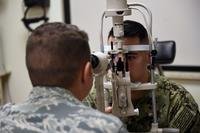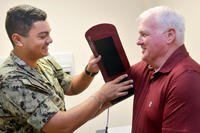 Military Update: Isakson Vows to Soften 40-Mile Limit on VA 'Choice Card'
Military Update: Isakson Vows to Soften 40-Mile Limit on VA 'Choice Card'
Sen. Johnny Isakson (R-Ga.), new chairman of the Senate Veterans Affairs Committee, promises to push for two critical changes to soften a restrictive 40-mile rule on user eligibility under the VA Choice Card program.
If Isakson succeeds, thousands more veterans would gain routine access to government-paid healthcare in the private sector. His challenge is that the changes sought could drive up health care costs for the Department of Veterans Affairs by billions of dollars annually.
Isakson said he believes Rep. Jeff Miller (R-Fla.), chairman of the House Veterans Affairs Committee, also will support softening the 40-mile rule. Miller indicated as much, but suggested it could be paid for using the same $10 billion Congress approved last year to expand private sector care to veterans, thwarting VA plans to divert some of that to other priorities.
Representatives of veterans’ service organizations predicted last summer that many veterans would be angered and confused by the arbitrary way Congress shaped a 40-mile rule for use of new Choice Cards under the Veterans Choice, Access and Accountability Act of 2014.
The predictions are now reality as members of Congress are swamped with complaints from frustrated veterans who find they can’t use their cards to get care from local doctors and hospitals, even though they live more than 40 miles from VA health care or face waits for care longer than 30 days.
As we reported here several times last year, the law is more restrictive than early Capitol Hill tweets had indicated. For each episode of care, regional VA healthcare managers still must authorize outside care, and VA usually will direct patients into a contracted network of health care providers.
Meanwhile, the 40-mile rule narrows eligibility to use cards in two ways. First, the law uses “geodesic” or as-the-crow-flies distance to determine if a veteran lives more than 40 miles from VA care. This denies access to private sector care to many vets who reside within 40 miles of VA care if one uses a map and ruler. Actual drives for care can be much longer.
Second, the 40-mile rule applies to the nearest VA health facility, not nearest VA facility providing needed care. So veterans who reside within 40 miles of a VA clinic that can’t treat their conditions still aren’t eligible to use the Choice Card. Those are two problems that need fixing, Isakson said.
“We need to make sure that if [VA] health care within 40 miles of the veteran doesn’t provide chemotherapy or doesn’t provide a heart transplant or doesn’t provide a specialty the veteran needs, they get to exercise the 40-mile rule because the health care they need is not available,” said Isakson.
“We also need to be certain we look at how long it takes to drive there…This straight-line application is crazy,” Isakson said. “It needs to be the time [or mileage] from leaving the garage of the veteran to pulling into the parking lot of the Veterans Administration.”
Some lawmakers blamed VA for “interpreting” the law so rigidly, perhaps to hold down costs. But at a joint hearing of the House and Senate veterans affairs committees last week, where Disabled American Veterans had its turn presenting budget priorities for 2016, its legislative director, Joseph Violante, suggested the blame was misplaced. It was Congress that set in law the narrow scope of the 40-mile rule in negotiating the Choice Act.
Rep. Jeff Miller (R-Fla.), chairman of the House veterans affairs committee, conceded that point, telling colleagues that without restraints, the Act would have cost $50 billion over three years, as scored by the Congressional Budget Office. Miller and colleagues wanted the Choice Card, a high-profile solution to the patient wait-time scandal, kept to a more “manageable number” of $10 billion. CBO calculated it could be, if the 40-mile rule were tightened as prescribed during the three-year pilot program.
“So it’s the way we had to write it to stay under the $10 billion,” Miller explained.
Miller added that VA Secretary Bob McDonald has signaled the 40-mile rule can be eased. He did so by seeking authority in the 2016 budget to divert some of the $10 billion for Choice into other accounts. That is money, Miller said, that Congress only wants used to buy private sector care for veterans who otherwise face long waits or long commutes to get VA care.
“The secretary’s already said there’s a big pot of money -- $10 billion -- he’d like to dip into…We would rather expand the Choice program.”
Louis Celli, director of veterans’ affairs and rehabilitation for The American Legion, agreed with that approach, finding it “interesting” that the secretary, six months after passage of the Choice Act, wants authority to reprogram some of the $10 billion because it likely won’t be needed.
“If that’s the case,” Celli said, “then Congress should have no problem expanding that program to take advantage of those access funds…And what better to expand than to include some of the veterans who were purposely carved out after CBO originally scored this program at $50 billion.”
Other major vet groups, including Veterans of Foreign War, Vietnam Veterans of America, also want the 40-mile rule relaxed. They advised that most veterans still prefer VA health care if available. Some vets are even reluctant to use Choice Cards given past bad experiences with timely reimbursements and other problems using VA-directed private sector care.
McDonald testified last week that VA merely is seeking budget flexibility to provide needed care to vets, regardless of venue. He said 500,000 veterans had contacted VA about using Choice Cards since the first batch were mailed last November. The final batch went out in January. Yet only 30,000 vets so far had used Choice Cards to arrange private sector care appointments, a number that even McDonald described as “awfully low.”
McDonald said if the slow pace held after months more of data collection he too would support legislation to relax the 40-mile rule.
“We’ve got to do a better job marketing,” McDonald conceded. That push is underway, he said, and it includes a new public service ad which vets can view at: https://www.youtube.com/watch?v=i9nnsRlX5b8&feature=player_embedded
To comment, write Military Update, P.O. Box 231111, Centreville, VA, or email milupdate@aol.com or twitter: Tom Philpott @Military_Update
# # # #
Tom Philpott has been breaking news for and about military people since 1977. After service in the Coast Guard, and 17 years as a reporter and senior editor with Army Times Publishing Company, Tom launched "Military Update," his syndicated weekly news column, in 1994. "Military Update" features timely news and analysis on issues affecting active duty members, reservists, retirees and their families.
Visit Tom Philpott's Military Update Archive to view his past articles.
Tom also edits a reader reaction column, "Military Forum." The online "home" for both features is Military.com.
 Tom's freelance articles have appeared in numerous magazines including The New Yorker, Reader's Digest and Washingtonian.
Tom's freelance articles have appeared in numerous magazines including The New Yorker, Reader's Digest and Washingtonian.
His critically-acclaimed book, Glory Denied, on the extraordinary ordeal and heroism of Col. Floyd "Jim" Thompson, the longest-held prisoner of war in American history, is available in hardcover and paperback.



